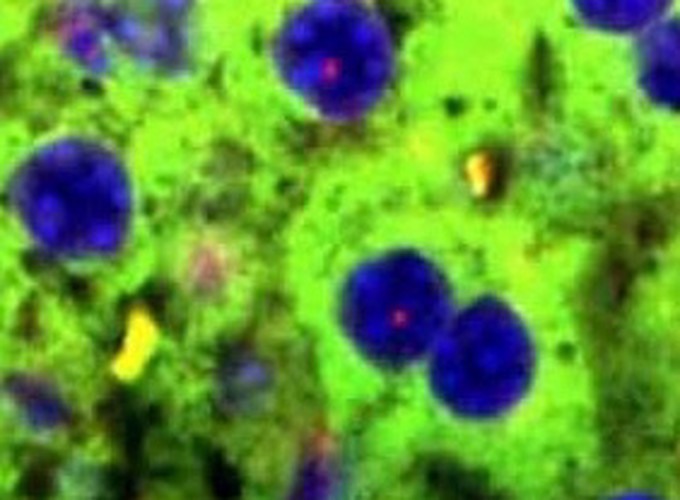Generate Y chromosome template DNA
If you are starting with an aliquot of 2-4 µl template DNA, amplify the DNA several (2-3) times by DOP-PCR to generate Y chromosome template. This will be your Y chromosome template stock. Then each time you make probe use DNA from this stock for another batch (8 reaction) DOP-PCR and subsequent labeling. Do not repeatedly amplify DOP-PCR as this can bias the oligos generated by selecting for a subpopulation of oligos that amplify particularly well.
We usually generate Y probe in bulk by making a master mix for 10 PCR reactions. We then make 8 DOP-PCR reactions, have one no DNA control and 1 excess reaction for pipetting error. This bulk reaction gives us 1.6 mls of Y probe, roughly enough to stain 160 slides.
DOP-PCR
(degenerate oligonucleo primed-polymerase chain reaction)
PCR reaction, 50 µl total volume
| Reagent | 1 reaction | 10 reactions |
|---|---|---|
| Water | 40.3 µL | 403 µL |
| 10x PCR buffer | 5 µL | 50 µL |
| 10 mM dNTP | 1.2 µL | 12 µL |
| 100 µM 6AI primer | 1 µL | 10 µL |
| Taq stock 5U/ µl | 0.5 µL | 5 µL |
| (Roche cat# 1435094) |
Take out 48 µl for no DNA control, place in a labeled 0.2ml tube.
Add DNA
| Reagent | 1 reaction | 9 reactions |
|---|---|---|
| Mouse Y chromosome DNA | 2 µL | 18 µL |
Pipette 50 µl into 8 tubes
6AI Primer = CCG ACT CGA GNN NNN NTA CAC C where N is an equal concentration of all nucleotides
| PCR cycle | Denaturing | Annealing | Extension |
|---|---|---|---|
| 1-2 cycles | 45sec/94°C | 45sec/15°C | 12min/37°C |
| 5 cycles | 40sec/94°C | 45sec/37°C | 4min/66°C |
| 24 cycles | 40sec/94°C | 45sec/54°C | 4min/66°C |
For bulk DOP-PCR, pipet all the reactions together after cycling. Then run 5 µl pooled DOP-PCR reaction and 5 µl no-DNA control on a 2% agarose gel alongside a 100 bp marker. The DOP-PCR reaction produces a smear that runs from approximately 300 to 2.5 kb. Next ethanol precipitate the pooled DOP-PCR DNA overnight by adding 1⁄10 the volume of 3M NaOAc, vortexing and then adding 2.5x the volume 100% ethanol and leaving at -20°C ON. The next day centrifuge the solution at 14,000 rpm for 30 min to pellet the DNA. Next wash the pellet in 70% ethanol and air-dry. Resuspend the pellet in the starting volume of distilled water (50 µl per PCR reaction, 400 µl for 8 reactions pooled).
Making the Y probe
DIG-Nick Translation
The next step involves digesting the Y chromosome template DNA (DOP-PCR reaction) into smaller pieces and labeling these pieces with digoxigenin. This is done using the DIG-Nick translation kit (ROCHE cat# 1745876). Take out 5-20 µl of newly resuspended DOP-PCR and set aside.
| Reagent | 1 reaction | 8 reactions |
|---|---|---|
| Y Chromosome Template (DOP-PCR) | approx. 50 µl | approx. 400 µl |
| DIG-Nick Kit mix | 12.5 µl | 100 µl |
This is now your DIG-Nick reaction solution. Incubate at 15 °C for 90 min to 2 hrs. Put the reaction on ice and run the reaction on a 2% agarose gel alongside the 5 µl of DOP-PCR you set aside earlier and some 100bp marker. You expect to see smear of fragments ranging from 150-500 bp. If this is the case, stop the reaction. If the smear still contains larger sized fragments, return the reaction to 15°C and check again on a 2% agarose gel every 10-20 min until the reaction contains the appropriate fragment sizes.
To stop the reaction:
| Reagent | 1 reaction | 8 reactions |
|---|---|---|
| DIG-Nick reaction | 62.5 µl | 500 µl |
| 0.5M EDTA | 4 µl | 32 µl |
and incubate at 65°C for 10 min.
Ethanol precipitation with carrier and blocker DNA
Aliquot the DIG-Nick reaction by placing 100 µl of it into several 1.5 ml eppendorfs. Scale up or down as necessary.
| Reagent | 1 reaction |
|---|---|
| DIG-Nick reaction | 100 µl |
| Sonicated Salmon sperm 10mg/ml (Stratagene cat#21190) | 4 µl |
| Cot-1 DNA 1mg/ml (Invitrogen cat#18440-016) | 100 µl |
| 3 M NaOAC (then vortex) | 26 µl |
| 100% ethanol | 800 µl |
Vortex again and leave ON at –20°C. Centrifuge at 14,000 rpm for 30 min to pellet the DNA. Next wash the pellet in 70% ethanol and air-dry. Resuspend the pellet in 100 µl formamide DI (deionized). Make sure the pellet is completely resuspended by heating the solution to 42°C for 10 min or higher if necessary. Then add an equal volume of hybridization buffer and store the probe at -20°C.
Hybridization Buffer
For 20 mls:
8 mls 50% Dextran Sulfate - end conc. 20% Dextran Sulfate
4 mls 20x SSC - end conc. 4x SSC
8 mls H2O
